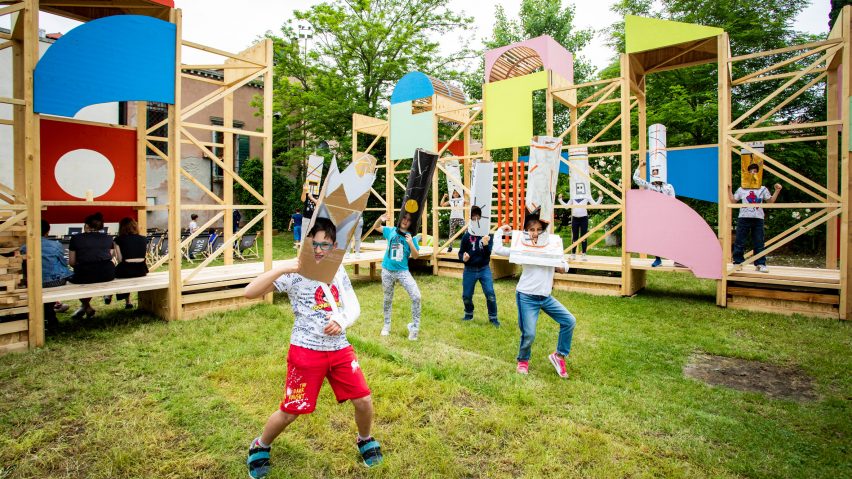A colourful interactive frame that Baxendale created as part of Scotland's contribution to the Venice Architecture Biennale 2018 has been saved from being dismantled.
Originally due to be taken down at the end of June – as the Scottish budget didn't cover renting the space at Palazzo Zenobio for the entire length of the biennale – the all-ages playground has proved too popular to lose.
The Armenian Mekhitarist Fathers of Venice, the organisation hosting the structure, bought it from the Glasgow-based architecture studio for a token amount of one euro and one cent.
A small team is now taking care of the structure until the biennale finishes in November, with local groups taking charge of happenings on the site.
"The way that local people and groups have taken up the invitation provided by the project has been truly humbling and inspiring," Baxendale co-founder Lee Ivett told Dezeen.
Freespace was the theme chosen by this years biennale directors, Grafton Architects founders Yvonne Farrell and Shelley McNamara.
"The project has become a freespace in every sense of the word and provided something meaningful and useful to local people within the context of the biennale, which in many ways often creates a kind of noise that many ordinary Venetians are not interested in hearing," continued Ivett.
As part of the wider Scottish programme of events at Venice, called Happenstance, the structure has hosted a musical, film screenings, community meetings, activist groups, local schools and families.
"The project is one of never ending potentially and having passed it's first 'deadline' it is interesting to see what happens within the space from now until November and beyond," said Ivett.
"Every new event and happening that we hear about is a fantastic surprise."
Baxendale designed the the Happenstance structure as part of Scotland's Year of Young People, collaborating with Glasgow-based art organisation WAVEparticle and local youth groups to put together a "living library of ideas" to bring to Venice.
An interconnected frame of raised walkways, latticed walls and towers topped by colourful and irregular-shaped roofs sits in the palazzo garden surrounded by deckchairs. Part meeting place, part playground, the project was designed to appeal to both adults and children.
"The design of the armature was intended to test ideas that myself and Ambrose [Gillic, Baxendale co-founder] had about the role of design for facilitating peoples' agency within public space," said Ivett.
"We are interested in what constitutes successful public space and how to enact design that suggests rather than dictates behaviour."
Although its future beyond November is uncertain, Baxendale designed the Happenstance frame as a kit of parts that could be reused, adapted or replicated to to suit a multitude of public spaces.
"Our hope is this model for activating and animating space through a unique collaboration of architects and artists and local people is what lasts. Working in a way that creates momentum, develops local capacity, creates local agency and tests multiple possibilities."
The Venice Biennale will run until 25 November 2018. Discover more interactive installations at the exhibition with Dezeen's guide to the top 10.
Photos by Basharat Khan.

